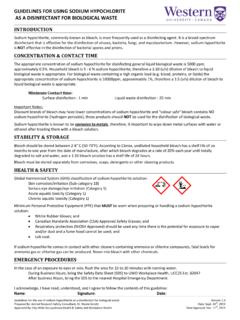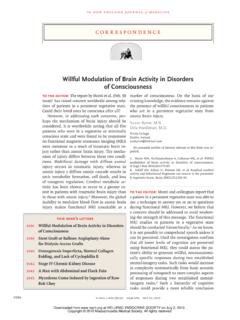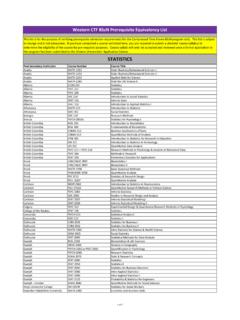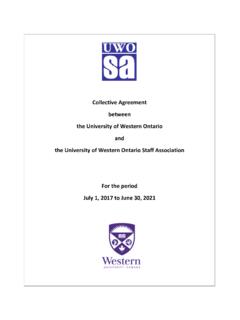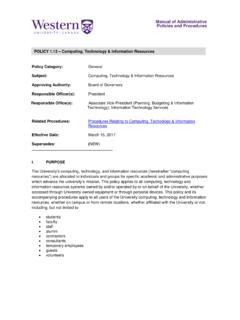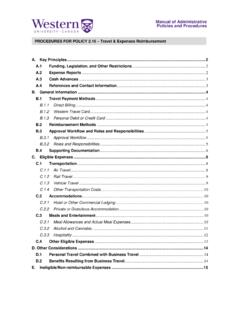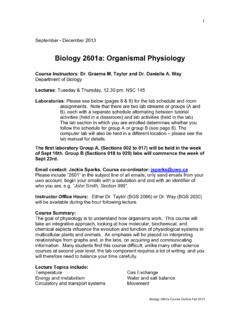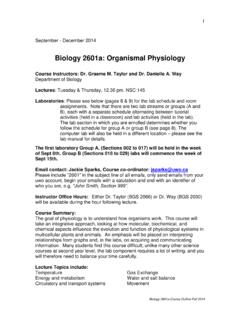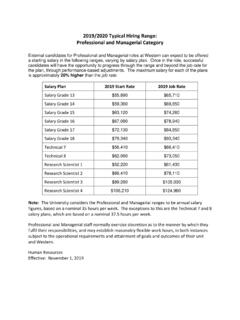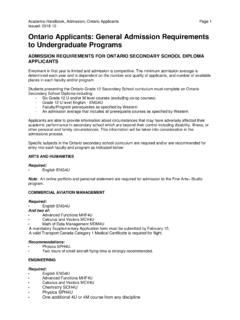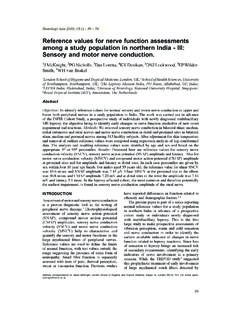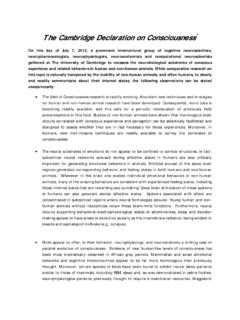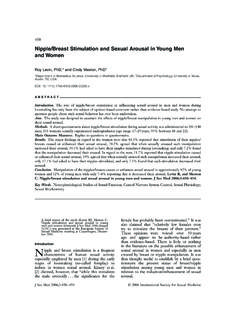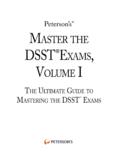Transcription of Working Memory: Imaging the Magic Dispatch Number Four
1 Working memory : Imaging the MagicNumber FourAdrian M. OwenMany brain regions have been implicated in memoryperformance, but the relationship between memorycapacity and neural activity has not been studies show that activity in the posteriorparietal cortex increases with Working memory load,implicating this region in the storage of representa-tions in visual memory has been described in various ways:as a cognitive system for both the temporary storageand manipulation of remembered information [1,2]; asthe type of memory that is active and only relevant fora short period of time [3,4]; and as the specific processby which a remembered stimulus is held on-line toguide behaviour in the absence of external cues orprompts [5].
2 While definitions vary, few disagree thatworking memory capacity refers to the Number ofitems of information that can maintained over a shortdelay interval and contributes to performance on awide variety of cognitive tasks, from complex decisionmaking to selective attention and language [1].In spite of this, a precise neurophysiological correlateof Working memory storage capacity has not previouslybeen identified. A common assumption in both electro-physiological recording studies in monkeys and func-tional neuroimaging studies in humans is that activitythat is sustained during a delay period reflects mainte-nance or storage processes, and may therefore providea key to the neural basis of known limits on storagecapacity.
3 For example, several early single-unit record-ing studies revealed sustained neuronal firing in thelateral frontal cortex of monkeys during the retentioninterval of delayed response tasks [6,7], suggesting thetemporary storage of some aspect of the stimulus to beremembered. But visual-form-specific neurons withactivity that is sustained during a delay have also beenfound in area TE and in perirhinal cortex in the anteriortemporal lobe [8,9], while delay-dependent spatialworking memory neurons have been identified in theparietal cortex [10].In humans, several event-related functional magneticresonance Imaging (fMRI) studies [11 13] have alsofound persistent frontal-lobe activity during retentionintervals of delayed response tasks.
4 But some of thesestudies have failed to show a relationship betweenfrontal activity and memory load in such tasks, arguingagainst a role for this region in basic storage processes[13]. Moreover, sustained activity during delays, broadlysimilar to that observed in the frontal-lobe, has alsobeen reported in other cortical regions, such as thedorsal premotor and posterior parietal cortices [14].The question that arises, therefore, is whether workingmemory storage can in fact be localised at all, orwhether it is simply a general property of a distributedneural system. Two recent studies [15,16] have shedlight on this issue by identifying, for the first time, neuro-physiological correlates of Working memory capacity inhumans.
5 Vogel and Machizawa [15] recorded event-related potentials (ERPs) from healthy young adultswhile they performed a simple visual memory task. Oneach trial, an array of coloured squares was presentedfor 100 milliseconds and the volunteers were required toremember the items in one hemifield. memory wastested one second later by presenting a test array thatwas either identical to the remembered array or differedby one approximately 200 milliseconds after theonset of the memory array and persisting throughoutthe retention interval, a large negative voltage wasobserved over posterior parietal and lateral occipitalelectrode sites in the hemisphere contralateral to theremembered items.
6 Moreover, increasing the numberof items in the memory array between one and threesquares increased the size of the observed effect, con-sistent with the notion that amplitude is sensitive to thenumber of representations that are being held in visualworking memory . In contrast, when the array size wasincreased beyond normal memory capacity approx-imately three items to six, eight and ten items perside, there was no significant increase in amplitude. This provides a further indication that delay activityreflects the specific maintenance of representations invisual memory , reaching a limit at approximately fouritems. Indeed, a significant limitation of previousneurophysiological studies that have reported memoryload effects has been that the amount of activitycontinues to increase for loads that exceed memorycapacity [11,17], suggesting that these measures reflectthe contribution of other, less fundamental, mnemonicprocesses such as increased executive processing,arousal or general new findings of Vogel and Machizawa [15]
7 Demonstrate, for the first time, a direct relationshipbetween neural activity and memory capacity, althoughgiven the limited spatial resolution of ERPs the preciseneural locus of this relationship is less clear. Todd andMarois [16] have recently addressed this issue usingevent-related fMRI and a similar behavioural volunteers were presented with a sampledisplay of between one and eight coloured disks, andfollowing a 1200 milliseconds delay were required todecide whether a probe disk matched one of thesample disks in both colour and in the other new study, Todd and Marois [16]found that performance declined with increasing setsize, levelling off at between three and four items whenvisual memory capacity was reached.
8 The Imaging dataDispatchCurrent Biology, Vol. 14, R573 R574, July 27, 2004, 2004 Elsevier Ltd. All rights reserved. DOI Cognition and Brain Sciences Unit, 15, Chaucer Road,Cambridge CB2 2EF, UK. E-mail: that activity within a single bilaterally symmet-ric region of the intraparietal and intraoccipital sulci cor-related with the Number of objects encoded, reaching aplateau by set size four. Crucially, the general effects oftask difficulty could be ruled out because, beyond setsize four, accuracy decreased and reaction timesincreased, yet activity in this region remained constant,as did the Number of items successfully a subsequent experiment, a longer, 9200 millisec-ond retention interval was used to examine separatelywhether the observed load-dependent activity wasrelated to the encoding, maintenance or retrieval ofinformation.
9 The intraparietal and intraoccipital sulciwere more active at larger set sizes during both encod-ing and maintenance, but not during retrieval. Theseresults strongly suggest that the posterior parietal cortexacts as a capacity-limited store for the representation ofvisual information. Moreover, no such relationship wasdemonstrated for any lateral frontal-lobe region, evenwhen significance thresholds were relaxed tenfold. These two studies [15,16] are entirely consistent withthose Working memory models that have assumed thatstorage of information occurs in posterior corticalassociation areas, including the parietal cortex, whilethe frontal-lobe contribution is via various top-down executive processes on those stored representations[2,18,19].
10 According to such models, sustained frontal-lobe activity does not reflect storage per se, but rather,operations such as active rehearsal and strategicencoding ( chunking , for example) that are essentialfor maintaining a stored representation across pro-longed and/or interrupted delays and when storagedemands exceed capacity. In fact, recent fMRI studieshave suggested that, under certain circumstances,frontal-lobe activity may be entirely dissociated frombasic storage demands. For example, where the infor-mation to be remembered can be strategically recodedthrough chunking, frontal-lobe activity has been shownto increase, while Working memory demand effectivelydecreases [20].
